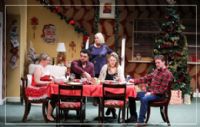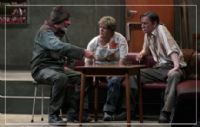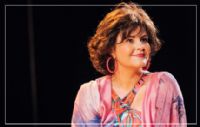REVIEW: Under The Hawthorn Tree
Date: 17/05/2019
Theatre Review

Cahoots NI’s Under The Hawthorn Tree, adapted by Charles Way from Marita Conlon-McKenna’s popular children’s novel, is a spellbinding spoken-and-sung story with relatable characters and themes, a compellingly crafted play about persistence through and from poverty. Eluding the tricky tonal imbalance that hampers many a concise ensemble piece, Paul Bosco McEneaney’s production finds heart, life and magic in an exemplary trio of central performers wedded to uniquely appealing choreography, impressive spot effects, a devoted and colourful supporting cast, and another fine score from the Garth McConaghie library. All in a mere sixty-five minutes.
Under The Hawthorn Tree is, literally, where one life ends and new lives begin. It is beneath the titular tree where baby Bridget O’Driscoll, dead from an illness, is buried whilst her mother Margaret (Colette Lennon Dougal, more serious and reserved than usual) and siblings Eily (Maeve Smyth), Michael (Terence Keeley) and Peggy (Philippa O’Hara) work out how to cope in light of a seismic event - the 1840s potato famine that has destroyed this rural Irish family’s plot.
Now that the O’Driscolls can’t grow food, they must buy it, meaning father John (Frankie McCafferty, sound) must leave home to work on the roads. Worried about the lengthy disappearance of her husband and ever-dwindling supplies, Margaret later leaves herself to look for him, and isn’t seen for some time.
Believing themselves alienated, and knowing that if found to be living alone they will be sent to the workhouse, the children must now summon their inner and outer strength for a long and dangerous quest to find distant relatives. It is life changing for all them, bringing out leadership qualities in Eily, sometimes foolhardy but always well-intentioned bravado in Michael, and fragile tentativeness in Peggy. For Peggy it is especially serious, as being the youngest O’Driscoll she leaves with arguably the most sheltered mindset.
On their journey they are given medicine and advice by the mysterious Mary Kate (Maggie Cronin) and promised “lamb soup” (ugh!) by the friendly Joseph T. Lucy (Adam Dougal). But will they really help, or have the children simply no choice but to believe they will help? This is an Ireland where “even the good turn to wolves” if they are hungry, and where, when poverty-stricken, the line between oasis and mirage becomes as thin and fragile as the body itself.
It is a captivating fantasy and painful reality at once, performed superbly by Maeve Smyth, Terence Keeley and Philippa O’Hara. Adapting their speaking and singing voices to convincingly reflect suffering, and aligning their physicality to Carlos Pons Guerra’s ingenious choreography, all three actors get under the O’Driscoll siblings’ skins. They unite themselves and the audience with showings of forceful dynamism on circular, slanted foundations which reflect the edginess of the children’s lives, perhaps most notably in a magical sequence where a rippled lighting effect is cast on to the stage while the actors wobble over “stepping stones” on a river. More frightening, but not too much so (this is a children’s story!), is an “attack by dogs” under flickering red and black lights which represents the deadly game of chance (roulette, even) that Eily, Michael and Peggy have been forced to play with nature.
But Under The Hawthorn Tree is more than a play, or even a fable about adaptation. In the present day it attains a cultural, even political, resonance - with the after effects of a still recent fire causing disruption in the centre of Belfast, and a still impending Brexit looming, we are no longer as certain of where we are or where we’re going to go. With this in mind, McEneaney’s work inspires by depicting the possibility of new strength and unity from potential fear and alienation – in a populace who are simply looking, like the O’Driscolls, for the safety and warmth of a comfortable home.
Simon Fallaha
Under The Hawthorn Tree was a production by Cahoots NI and ran at Belfast's MAC Theatre from 27 September - 07 October. Photography by Carrie Davenport. Review appeared in The Big List 300.
Under The Hawthorn Tree is, literally, where one life ends and new lives begin. It is beneath the titular tree where baby Bridget O’Driscoll, dead from an illness, is buried whilst her mother Margaret (Colette Lennon Dougal, more serious and reserved than usual) and siblings Eily (Maeve Smyth), Michael (Terence Keeley) and Peggy (Philippa O’Hara) work out how to cope in light of a seismic event - the 1840s potato famine that has destroyed this rural Irish family’s plot.
Now that the O’Driscolls can’t grow food, they must buy it, meaning father John (Frankie McCafferty, sound) must leave home to work on the roads. Worried about the lengthy disappearance of her husband and ever-dwindling supplies, Margaret later leaves herself to look for him, and isn’t seen for some time.
Believing themselves alienated, and knowing that if found to be living alone they will be sent to the workhouse, the children must now summon their inner and outer strength for a long and dangerous quest to find distant relatives. It is life changing for all them, bringing out leadership qualities in Eily, sometimes foolhardy but always well-intentioned bravado in Michael, and fragile tentativeness in Peggy. For Peggy it is especially serious, as being the youngest O’Driscoll she leaves with arguably the most sheltered mindset.
On their journey they are given medicine and advice by the mysterious Mary Kate (Maggie Cronin) and promised “lamb soup” (ugh!) by the friendly Joseph T. Lucy (Adam Dougal). But will they really help, or have the children simply no choice but to believe they will help? This is an Ireland where “even the good turn to wolves” if they are hungry, and where, when poverty-stricken, the line between oasis and mirage becomes as thin and fragile as the body itself.
It is a captivating fantasy and painful reality at once, performed superbly by Maeve Smyth, Terence Keeley and Philippa O’Hara. Adapting their speaking and singing voices to convincingly reflect suffering, and aligning their physicality to Carlos Pons Guerra’s ingenious choreography, all three actors get under the O’Driscoll siblings’ skins. They unite themselves and the audience with showings of forceful dynamism on circular, slanted foundations which reflect the edginess of the children’s lives, perhaps most notably in a magical sequence where a rippled lighting effect is cast on to the stage while the actors wobble over “stepping stones” on a river. More frightening, but not too much so (this is a children’s story!), is an “attack by dogs” under flickering red and black lights which represents the deadly game of chance (roulette, even) that Eily, Michael and Peggy have been forced to play with nature.
But Under The Hawthorn Tree is more than a play, or even a fable about adaptation. In the present day it attains a cultural, even political, resonance - with the after effects of a still recent fire causing disruption in the centre of Belfast, and a still impending Brexit looming, we are no longer as certain of where we are or where we’re going to go. With this in mind, McEneaney’s work inspires by depicting the possibility of new strength and unity from potential fear and alienation – in a populace who are simply looking, like the O’Driscolls, for the safety and warmth of a comfortable home.
Simon Fallaha
Under The Hawthorn Tree was a production by Cahoots NI and ran at Belfast's MAC Theatre from 27 September - 07 October. Photography by Carrie Davenport. Review appeared in The Big List 300.




































